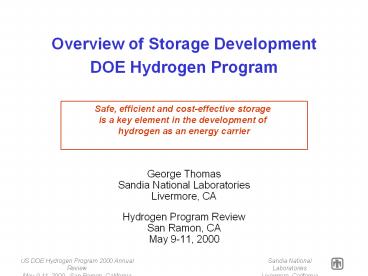Overview of Storage Development DOE Hydrogen Program PowerPoint PPT Presentation
Title: Overview of Storage Development DOE Hydrogen Program
1
Overview of Storage DevelopmentDOE Hydrogen
Program
Safe, efficient and cost-effective storage is a
key element in the development of hydrogen as an
energy carrier
- George Thomas
- Sandia National Laboratories
- Livermore, CA
- Hydrogen Program Review
- San Ramon, CA
- May 9-11, 2000
2
Hydrogen storage requires something more than a
can or a bucket
- Hydrogen has the highest mass energy density of
any fuel - 120 MJ/kg (LHV) 144 MJ/kg (HHV)
- however
- At ambient conditions (300 K, 1 atm.)
- the energy content of 1 liter of H2 is only 10.7
kJ, - three orders of magnitude too low for practical
applications. - Issues
- 1. What are the options available for storage?
- 2. What are the theoretical limits to storage
density and how close can we come? - 3. How do we organize a development program to
achieve adequate stored energy in an efficient,
safe and cost-effective manner?
3
Mass energy densities for various fuels
Increasing molecular wt.
4
Maximum energy density is achievedin liquid state
5
Hydrogen energy content in liquid fuels
Hydrogen density is nearly the same in all
fuels. This narrow range suggests a natural
benchmark for comparison of storage performance.
6
Maximum storage densities (w/o system)
Energy Density MJ/liter
- High pressure gas
- ambient temperature 3600 psi 2.0 5000 psi 2.75
- cryogenic system 150 K 3.5 20 K 8.4
- Liquid hydrogen 8.4
- Reversible storage media
- carbon structures
- nanotubes ?
- fullerenes ?
- hydrides
- intermetallics 10.8 - 12.0
- alanates 8.25
- composite materials ?
- Chemical methods Eff. gasoline
methanol - liquid fuel reformer 50 6.6 5.9
- 75 9.9 8.9
- off-board reprocessing ?
7
Programmatic guidelines
- A balanced program between scientific discovery
and engineering validation is needed. - Portion of program invested in high risk
approaches. - Collaboration with industry at all levels.
- International partnerships beneficial.
- Leverage off other programs.
- Program should not downselect technologies too
early - Options should be fully explored.
- Different technologies suited for different
applications. - Realistic goals should be set as metrics for
progress. - Evaluate goals on a continuing basis
- continue to refine roadmap
8
(No Transcript)
9
Materials Development
- Carbon nanotubes M. Heben, NREL
- near-term goal 6 wt.
- synthesis, processing, hydrogen
absorption/desorption - Carbon fullerenes R. Loutfy, MER
- feasibility of fullerene-based storage
- Alanate hydrides C. Jensen, Univ. of Hawaii
- NaAlH4 5.5 wt. hydrogen capacity
- catalysts, properties
- Hydride development K. Gross, SNL
- near-term goal 5.5 wt. at lt100 C (NaAlH4)
- bulk synthesis, scaled-up beds, characterization,
safety studies - Catalytically enhanced storage C. Jensen, Univ.
of Hawaii - new start
- Polymer dispersed metal hydrides T. Jarvi, United
Technologies
10
Pressure Tank Development
- Lightweight tanks F. Mitlitisky, LLNL
- goal gt10 wt. 5000 psi
- Conformable tanks R. Golde, Thiokol Propulsion
Co. - high pressure tanks with improved packing
efficiency - cryogenic hydrogen vessels S. Aceves, LLNL
- design and testing for improved volume density
- Composite tank testing B. Odegard, SNL
- comparison of high pressure hydrogen tank failure
to other fuels. - CNG, gasoline, methanol.
11
Engineering Validation
- PV/electrolysis/metal hydride K. Sapru, ECD
- modeling and integration of storage with
renewable energy sources - Metal hydride/ organic slurry R. Breault, Thermo
Power - chemical hydride for PEMFC vehicles
- hydrogen transmission and storage
- Fuelcell/hydride powerplant G. C. Story, SNL
- for underground mine and tunneling locomotive
- Thermal hydrogen compression D. DaCosta,
Ergenics, Inc. - new start
12
Other hydrogen storage programs (US)
- DOE/OTT
- Fuels for Fuel Cells Program (P. Devlin)
- Parallel development of fuel processor and
onboard H storage. - DOE/OIT
- Low cost hydrides for mine vehicles (SRTC)
- Part of Mining Industry of the Future
initiative. - IEA
- Task 12 will be completed Oct. 2000
- New task being formed Advanced Solid and Liquid
State Hydrogen Storage Materials (G. Sandrock) - Industry Projects
13
Other hydrogen storage programs (non US)
- Canadian Projects
- Alanates (A. Zaluska, McGill Univ.)
- Nanocrystalline Mg-based hydrides (Hydro-Quebec)
- Carbon adsorption (IRH)
- European Projects
- liquid hydrogen storage (BMW)
- refueling station (BMW)
- WENET (Japan)
- Metal-H complex ions (S. Suda, Kogakuin Univ.)
- others
14
Some highlights from this year
- Continuing progress in nanotubes
- high purity synthesis and processing methods.
- gt 6 wt. appears feasible.
- Important progress achieved on alanates
- 5.5 wt. at low temperatures appears feasible.
- Continued improvement in lightweight and
conformable tanks - more efficient packing of high pressure tanks
- integration of storage with applications
- PV system
- mine vehicle
- Three new starts
- catalyst enhanced storage
- polymer dispersed hydride
- thermal hydrogen compression

